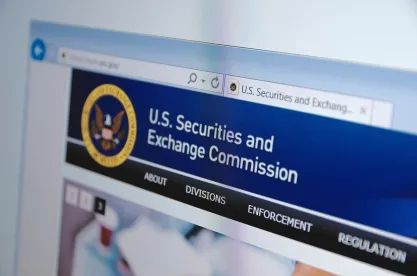On November 2, 2020, the Securities and Exchange Commission adopted amendments to the rules for certain exempt offerings under the Securities Act of 1933, as amended, in an effort to harmonize, simplify and improve the multilayer and overly complex exempt offering framework.1 These changes include: (1) increasing the offering limits for Regulation A, Regulation Crowdfunding, and Rule 504 offerings and revising certain individual investment limits; (2) establishing a new integration framework; (3) setting clear and consistent rules governing certain offering communications, including permitting certain “testthe-waters” and “demo day” activities; (4) streamlining the ability of issuers to move from one exemption to another and (5) harmonizing certain disclosure and eligibility requirements and bad actor disqualification provisions. This article addresses each of these changes and offers guidance on the likely impact that the amendments will have on exempt offerings and capital formation as a whole.
Regulation Crowdfunding limit raised from $1.07 million to $5 million
Generating the most excitement among entrepreneurs and small business owners is the amendment to Regulation Crowdfunding, which raises the crowdfunding limit from $1.07 million to $5 million in any 12-month period. “Crowdfunding” is a form of capital financing where small businesses use the internet to raise capital through investments from a large number of investors.2 Rather than raising money from a small pool of sophisticated investors, crowdfunding can be used to obtain capital from a large audience or “crowd.”3 Recognizing the needs of small businesses to more easily access capital and the emergence of crowdfunding websites like Kickstarter and GoFundMe, the JOBS Act was enacted in 2012, with Title III establishing crowdfunding provisions that allow earlystage businesses to offer and sell securities. In 2016, the SEC adopted Regulation Crowdfunding to implement the requirements of Title III of the JOBS Act.4
Since that time, Regulation Crowdfunding has proven to be a success. According to a report published by Crowdfund Capital Advisors in partnership with the Small Business & Entrepreneurship Council, 3,100 stock offerings have been listed by 2,600-plus companies under Regulation Crowdfunding and $500 million has been committed to these offerings.5
In its announcement, the SEC stated that it strongly believes that increasing the crowdfunding limit to $5 million will enable small businesses to access capital through exempt offerings even more effectively.6 We believe that the SEC’s confidence is well-founded and that these amendments will expand access to capital for small businesses and entrepreneurs throughout the United States. Prior to the amendments, Regulation Crowdfunding was rather limited – if a startup desired to raise more than $1.07 million, they would need to turn to another exemption in order to raise capital. That should no longer be the case based on the increased amounts. In the wake of these amendments, Regulation Crowdfunding is likely to become even more attractive, as a vast range of startups will now have the opportunity to tap into new pools of capital at a relatively low cost and barrier to entry. Moreover, the revamped Regulation Crowdfunding can serve an important role in supplying early-stage companies with easily accessible financing that will allow more and more companies to sustain operations and succeed.
In addition to raising the offering limit, the rule changes remove investment limits for accredited investors, use the greater of annual income or net worth when calculating the investment limits for non-accredited investors, and extend the temporary relief providing an exemption from certain financial statement review requirements for issuers offering $250,000 or less of securities in reliance on the exemption within a 12-month period. Furthermore, the amendments will now allow crowdfunders to “test-the-waters” before filing an offering document with the SEC. Overall, these changes are expected to further increase access to private markets, while also leveling the playing field by expanding opportunities for the general public to participate in exempt offerings.
Tier 2 Regulation A+ maximum offering amount increased from $50 to 75 Million
The Amendments to Regulation A+ raised both the maximum offering amount under Tier 2 from $50 million to $75 million and also raised the maximum offering amount for secondary sales from $15 million to $22.5 million. Furthermore, the amendments set forth rules that allow the use of certain special purpose vehicles (SPVs) that serve as a conduit for investors to encourage investing in issuers fundraising pursuant to Regulation Crowdfunding. Lastly, the amendments to Regulation A+ create eligibility restrictions on the use of Regulation A by issuers that are not current in their Exchange Act reporting obligations.
Rule 504 of Regulation D change
Rule 504 of Regulation D was amended to raise the maximum offering amount from $5 million to $10 million. This change is expected to generate significant interest among issuers looking to take advantage of additional fundraising opportunities through exempt offerings. Another important change is that issuers will now be able to “test-the-waters” for an exempt offering prior to deciding which exemption to utilize. Similar to Securities Act Rule 163B, adopted in September 2019, which extended the “test-the water” accommodation from only emerging growth companies to all issuers engaged in a public offering7 , non-public issuers under Rule 504 of Regulation D will now enjoy the same opportunities to gauge market interest before choosing an exemption. Additionally, the amendments provide that certain “demo day” communications – such as communications made in connection with a meeting sponsored by a college, local government, non-profit organization or angel investor group – will not be deemed general solicitation or general advertising. In the aggregate, we anticipate that these changes will afford issuers more flexibility in navigating the exempt offering framework.
New and Improved Integration Framework
Navigating the integration framework has historically been one of the most challenging tasks for non-public issuers. For example, if an issuer is using multiple private offering exemptions at the same time and the SEC determines that the offerings should be integrated, the issuer runs the risk of failing to comply with all requirements of each exemption, such as offering limitations or the use of general solicitation. This is one of the reasons that Chairman Clayton described the old exempt offering framework as “patchwork” and lacking unity.8 The recent amendments aim to simplify the integration issue in two ways. First, the amendments shift the integration analysis to focus on “whether the issuer can establish that each offering either complies with the registration requirements of the Securities Act, or that an exemption from registration is available for the particular offering.”9 Second, the amendments create four non-exclusive safe harbors:
-
any offering made more than 30 calendar days before the commencement of any other offering, or more than 30 calendar days after the termination or completion of any other offering; provided that: in the case where an exempt offering for which general solicitation is prohibited follows by 30 calendar days or more an offering that allows general solicitation, the issuer has a reasonable belief that the issuer either did not solicit such purchaser through the use of general solicitation or established a substantive relationship with such purchaser prior to the commencement of the exempt offering prohibiting general solicitation;
-
offers and sales made in compliance with Rule 701, pursuant to an employee benefit plan, or in compliance with Regulation S will not be integrated with other offerings;
-
an offering for which a Securities Act registration statement has been filed will not be integrated if it is made subsequent to:
-
a terminated or completed offering for which general solicitation is not permitted,
-
a terminated or completed offering for which general solicitation is permitted that was made only to qualified institutional buyers and institutional accredited investors, or
-
an offering for which general solicitation is permitted that terminated or was completed more than 30 calendar days prior to the commencement of the registered offering; and
-
-
offers and sales made in reliance on an exemption for which general solicitation is permitted if made subsequent to any terminated or completed offering. The SEC anticipates that the integration amendments will have the greatest effect on exempt offerings involving non-accredited investors, while expecting the effects on non-reporting issuers that raise financing from accredited investors without the use of general solicitation to be more limited.10
A great deal of issuers rely on multiple exemptions to meet their capital needs and we believe that the revised integration framework, coupled with the increased offering limitations and other changes described above, provide for further flexibility to issuers seeking to raise capital.
1 See 17 C.F.R. § 227, 229, 230, 239, 240, 249, 270, and 274
2 See Dylan J. Hans, Rules Are Meant to Be Amended: How Regulation Crowdfunding’s Final Rules Impact the Lives of Startups and Small Businesses, 83 Brook.
L. Rev., 1089, 1090 (2018)
3 See Thomas Lee Hazen, Crowdfunding or Fraudfunding? Social Networks and the Securities Laws–Why the Specially Tailored Exemption Must Be Conditioned
on Meaningful Disclosure, 90 N.C. L. REV. 1735, 1736 (2012)
4 See 17 C.F.R. § 227
5 See https://www.crowdfundinsider.com/wp-content/uploads/2020/09/Regulation-Crowdfunding-by-Congressional-District.pdf
6 See https://www.sec.gov/news/press-release/2020-273
7 See 7 CFR § 230.163
8 See https://www.sec.gov/news/press-release/2020-273
9 See https://www.sec.gov/news/press-release/2020-273
10 See https://www.sec.gov/rules/final/2020/33-10844.pdf, at 2
Co-author Brett Uslaner is a law clerk in the Corporate Practice Group.



 />i
/>i
